Service Marketing and Customer Relationship: A Study on Prime Steak Restaurant
VerifiedAdded on 2023/06/05
|12
|3207
|355
AI Summary
This report discusses the aspects of service marketing and customer relationship with a specific focus on service operations process that includes both front and back stage functions. It also includes a flowchart of service operations, significance of service encounters, and managerial implications.
Contribute Materials
Your contribution can guide someone’s learning journey. Share your
documents today.
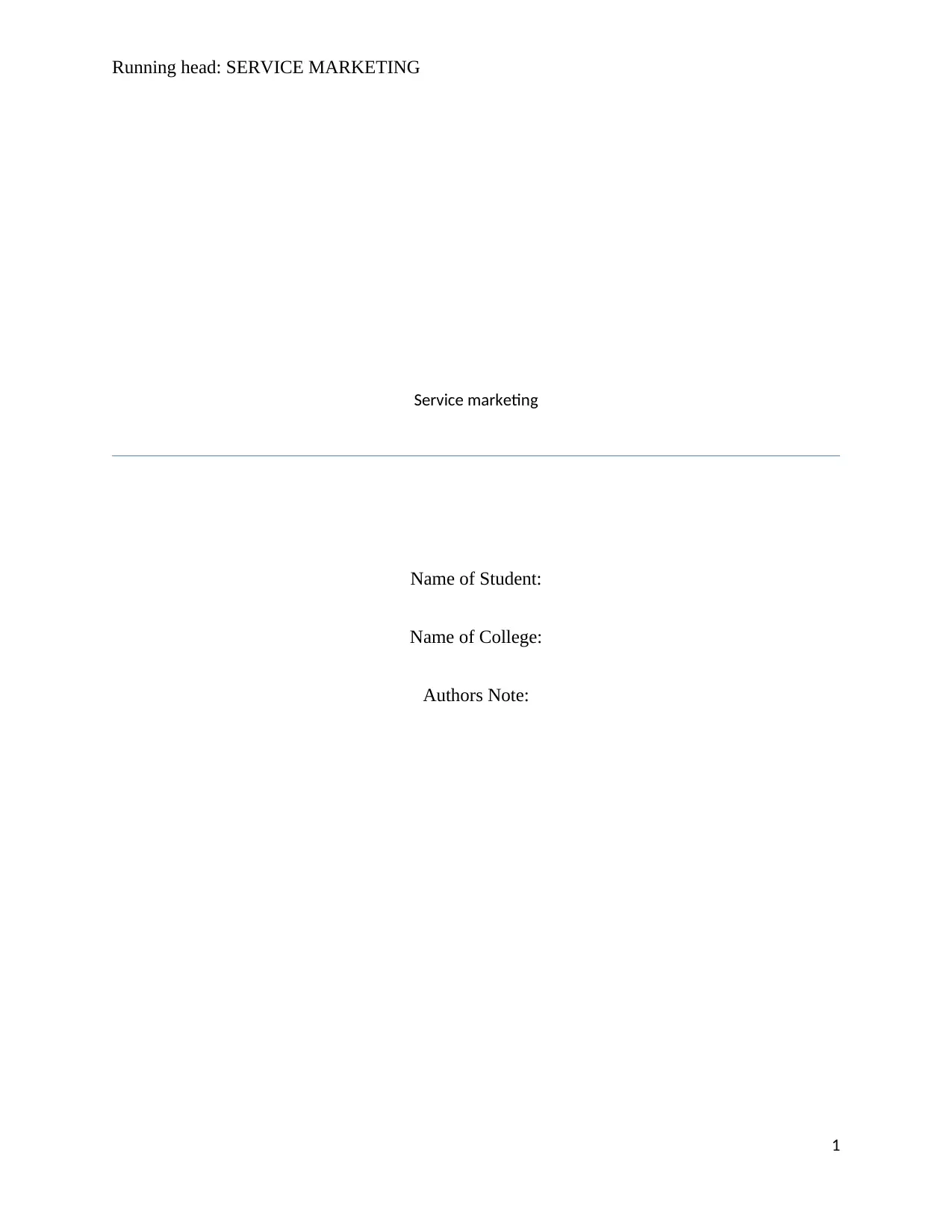
Running head: SERVICE MARKETING
Service marketing
Name of Student:
Name of College:
Authors Note:
1
Service marketing
Name of Student:
Name of College:
Authors Note:
1
Secure Best Marks with AI Grader
Need help grading? Try our AI Grader for instant feedback on your assignments.
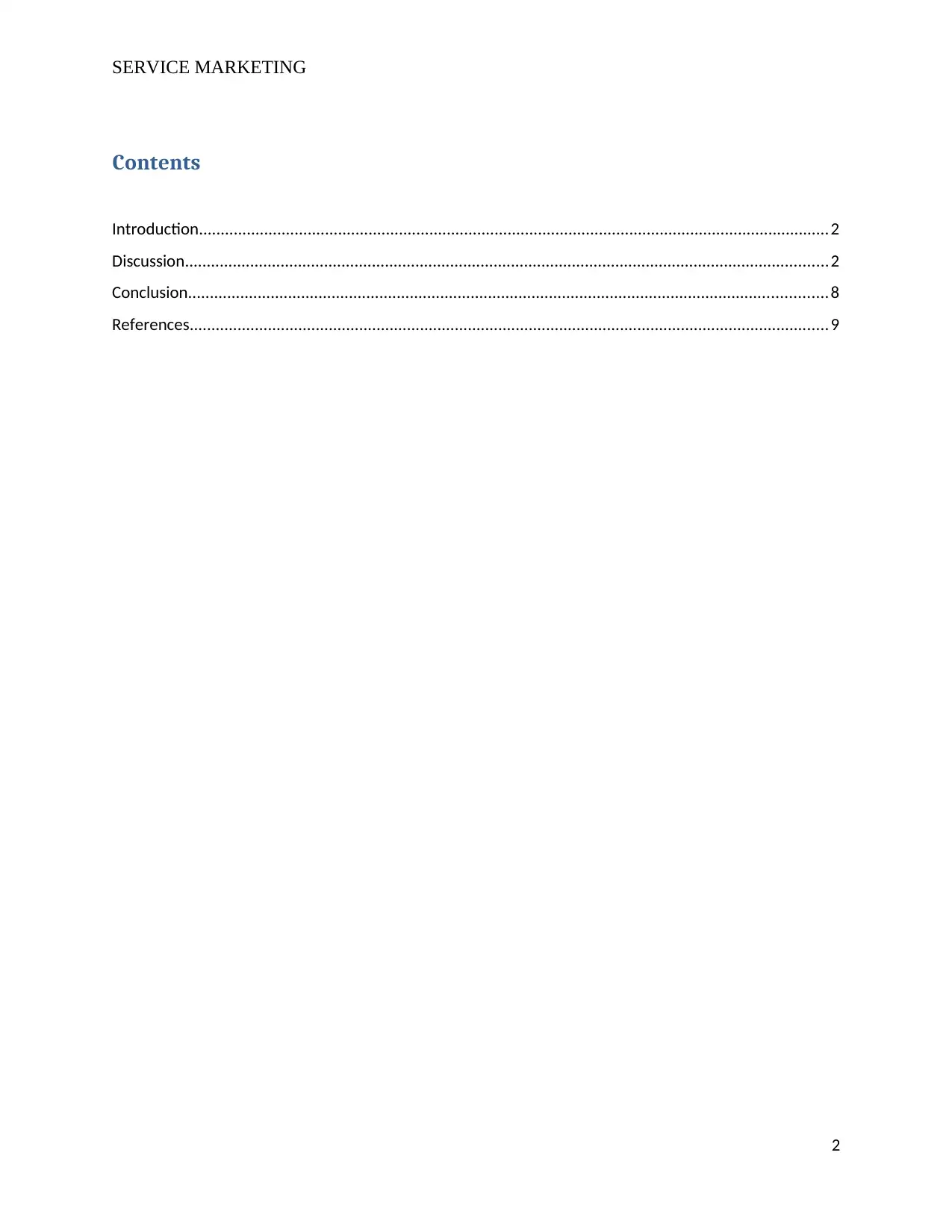
SERVICE MARKETING
Contents
Introduction.................................................................................................................................................2
Discussion....................................................................................................................................................2
Conclusion...................................................................................................................................................8
References...................................................................................................................................................9
2
Contents
Introduction.................................................................................................................................................2
Discussion....................................................................................................................................................2
Conclusion...................................................................................................................................................8
References...................................................................................................................................................9
2
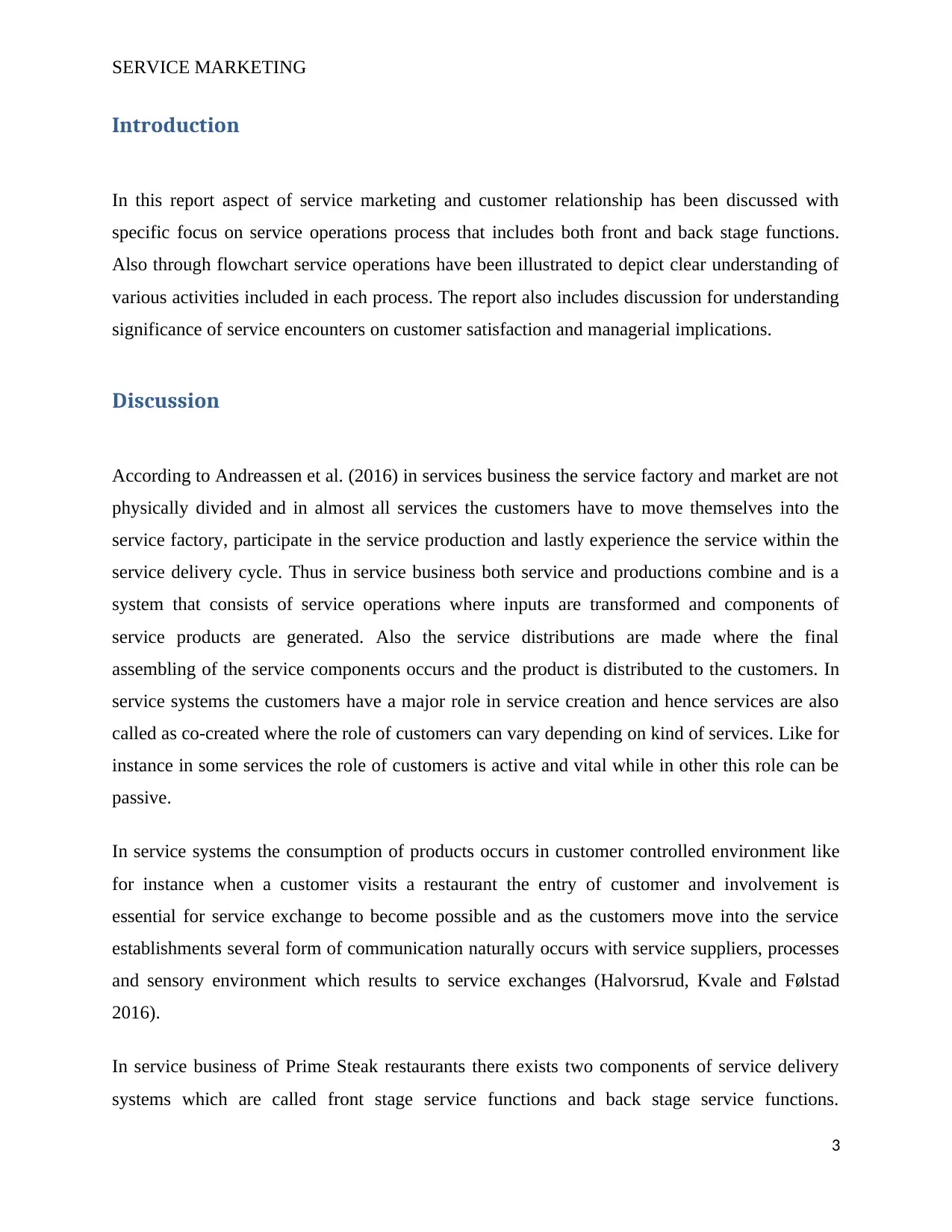
SERVICE MARKETING
Introduction
In this report aspect of service marketing and customer relationship has been discussed with
specific focus on service operations process that includes both front and back stage functions.
Also through flowchart service operations have been illustrated to depict clear understanding of
various activities included in each process. The report also includes discussion for understanding
significance of service encounters on customer satisfaction and managerial implications.
Discussion
According to Andreassen et al. (2016) in services business the service factory and market are not
physically divided and in almost all services the customers have to move themselves into the
service factory, participate in the service production and lastly experience the service within the
service delivery cycle. Thus in service business both service and productions combine and is a
system that consists of service operations where inputs are transformed and components of
service products are generated. Also the service distributions are made where the final
assembling of the service components occurs and the product is distributed to the customers. In
service systems the customers have a major role in service creation and hence services are also
called as co-created where the role of customers can vary depending on kind of services. Like for
instance in some services the role of customers is active and vital while in other this role can be
passive.
In service systems the consumption of products occurs in customer controlled environment like
for instance when a customer visits a restaurant the entry of customer and involvement is
essential for service exchange to become possible and as the customers move into the service
establishments several form of communication naturally occurs with service suppliers, processes
and sensory environment which results to service exchanges (Halvorsrud, Kvale and Følstad
2016).
In service business of Prime Steak restaurants there exists two components of service delivery
systems which are called front stage service functions and back stage service functions.
3
Introduction
In this report aspect of service marketing and customer relationship has been discussed with
specific focus on service operations process that includes both front and back stage functions.
Also through flowchart service operations have been illustrated to depict clear understanding of
various activities included in each process. The report also includes discussion for understanding
significance of service encounters on customer satisfaction and managerial implications.
Discussion
According to Andreassen et al. (2016) in services business the service factory and market are not
physically divided and in almost all services the customers have to move themselves into the
service factory, participate in the service production and lastly experience the service within the
service delivery cycle. Thus in service business both service and productions combine and is a
system that consists of service operations where inputs are transformed and components of
service products are generated. Also the service distributions are made where the final
assembling of the service components occurs and the product is distributed to the customers. In
service systems the customers have a major role in service creation and hence services are also
called as co-created where the role of customers can vary depending on kind of services. Like for
instance in some services the role of customers is active and vital while in other this role can be
passive.
In service systems the consumption of products occurs in customer controlled environment like
for instance when a customer visits a restaurant the entry of customer and involvement is
essential for service exchange to become possible and as the customers move into the service
establishments several form of communication naturally occurs with service suppliers, processes
and sensory environment which results to service exchanges (Halvorsrud, Kvale and Følstad
2016).
In service business of Prime Steak restaurants there exists two components of service delivery
systems which are called front stage service functions and back stage service functions.
3
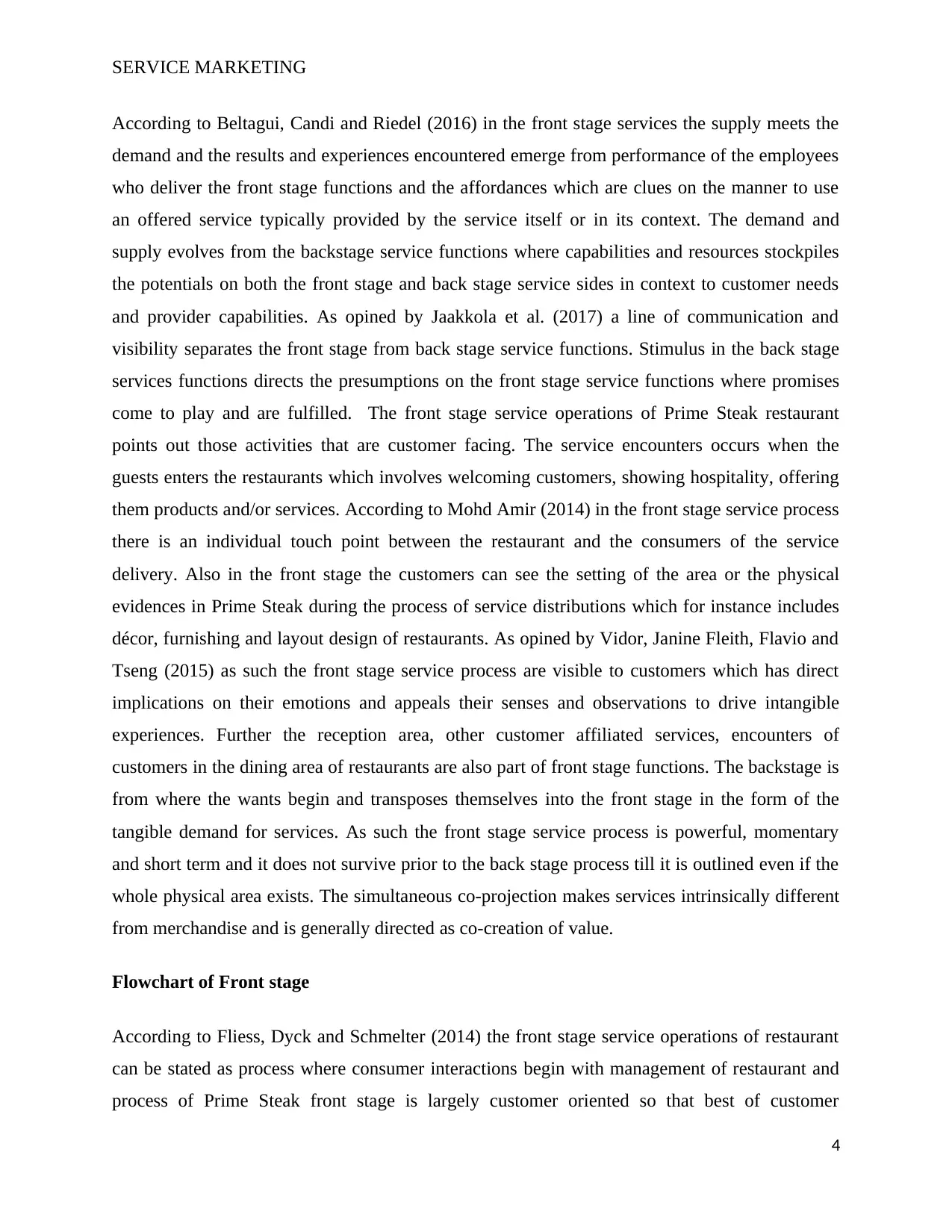
SERVICE MARKETING
According to Beltagui, Candi and Riedel (2016) in the front stage services the supply meets the
demand and the results and experiences encountered emerge from performance of the employees
who deliver the front stage functions and the affordances which are clues on the manner to use
an offered service typically provided by the service itself or in its context. The demand and
supply evolves from the backstage service functions where capabilities and resources stockpiles
the potentials on both the front stage and back stage service sides in context to customer needs
and provider capabilities. As opined by Jaakkola et al. (2017) a line of communication and
visibility separates the front stage from back stage service functions. Stimulus in the back stage
services functions directs the presumptions on the front stage service functions where promises
come to play and are fulfilled. The front stage service operations of Prime Steak restaurant
points out those activities that are customer facing. The service encounters occurs when the
guests enters the restaurants which involves welcoming customers, showing hospitality, offering
them products and/or services. According to Mohd Amir (2014) in the front stage service process
there is an individual touch point between the restaurant and the consumers of the service
delivery. Also in the front stage the customers can see the setting of the area or the physical
evidences in Prime Steak during the process of service distributions which for instance includes
décor, furnishing and layout design of restaurants. As opined by Vidor, Janine Fleith, Flavio and
Tseng (2015) as such the front stage service process are visible to customers which has direct
implications on their emotions and appeals their senses and observations to drive intangible
experiences. Further the reception area, other customer affiliated services, encounters of
customers in the dining area of restaurants are also part of front stage functions. The backstage is
from where the wants begin and transposes themselves into the front stage in the form of the
tangible demand for services. As such the front stage service process is powerful, momentary
and short term and it does not survive prior to the back stage process till it is outlined even if the
whole physical area exists. The simultaneous co-projection makes services intrinsically different
from merchandise and is generally directed as co-creation of value.
Flowchart of Front stage
According to Fliess, Dyck and Schmelter (2014) the front stage service operations of restaurant
can be stated as process where consumer interactions begin with management of restaurant and
process of Prime Steak front stage is largely customer oriented so that best of customer
4
According to Beltagui, Candi and Riedel (2016) in the front stage services the supply meets the
demand and the results and experiences encountered emerge from performance of the employees
who deliver the front stage functions and the affordances which are clues on the manner to use
an offered service typically provided by the service itself or in its context. The demand and
supply evolves from the backstage service functions where capabilities and resources stockpiles
the potentials on both the front stage and back stage service sides in context to customer needs
and provider capabilities. As opined by Jaakkola et al. (2017) a line of communication and
visibility separates the front stage from back stage service functions. Stimulus in the back stage
services functions directs the presumptions on the front stage service functions where promises
come to play and are fulfilled. The front stage service operations of Prime Steak restaurant
points out those activities that are customer facing. The service encounters occurs when the
guests enters the restaurants which involves welcoming customers, showing hospitality, offering
them products and/or services. According to Mohd Amir (2014) in the front stage service process
there is an individual touch point between the restaurant and the consumers of the service
delivery. Also in the front stage the customers can see the setting of the area or the physical
evidences in Prime Steak during the process of service distributions which for instance includes
décor, furnishing and layout design of restaurants. As opined by Vidor, Janine Fleith, Flavio and
Tseng (2015) as such the front stage service process are visible to customers which has direct
implications on their emotions and appeals their senses and observations to drive intangible
experiences. Further the reception area, other customer affiliated services, encounters of
customers in the dining area of restaurants are also part of front stage functions. The backstage is
from where the wants begin and transposes themselves into the front stage in the form of the
tangible demand for services. As such the front stage service process is powerful, momentary
and short term and it does not survive prior to the back stage process till it is outlined even if the
whole physical area exists. The simultaneous co-projection makes services intrinsically different
from merchandise and is generally directed as co-creation of value.
Flowchart of Front stage
According to Fliess, Dyck and Schmelter (2014) the front stage service operations of restaurant
can be stated as process where consumer interactions begin with management of restaurant and
process of Prime Steak front stage is largely customer oriented so that best of customer
4
Secure Best Marks with AI Grader
Need help grading? Try our AI Grader for instant feedback on your assignments.
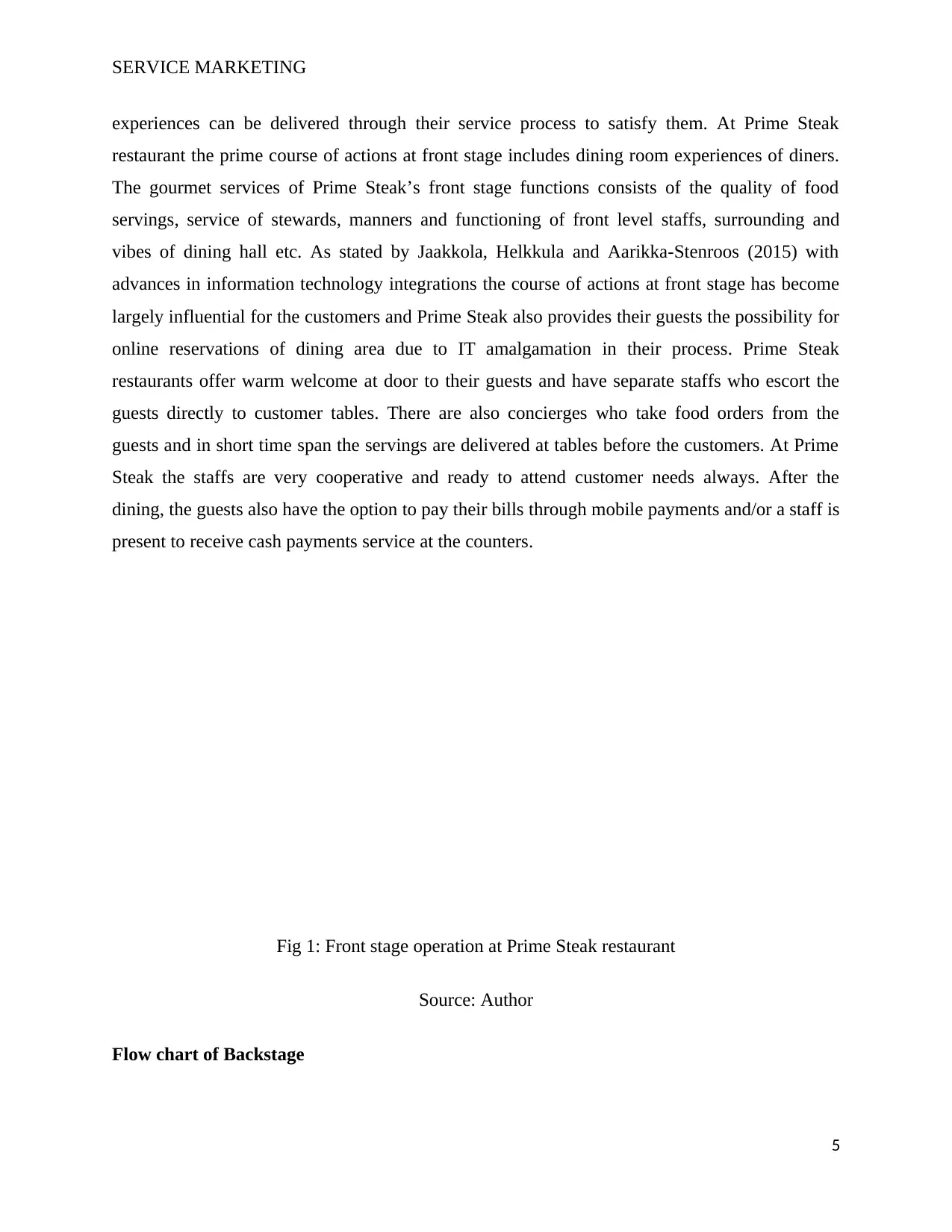
SERVICE MARKETING
experiences can be delivered through their service process to satisfy them. At Prime Steak
restaurant the prime course of actions at front stage includes dining room experiences of diners.
The gourmet services of Prime Steak’s front stage functions consists of the quality of food
servings, service of stewards, manners and functioning of front level staffs, surrounding and
vibes of dining hall etc. As stated by Jaakkola, Helkkula and Aarikka-Stenroos (2015) with
advances in information technology integrations the course of actions at front stage has become
largely influential for the customers and Prime Steak also provides their guests the possibility for
online reservations of dining area due to IT amalgamation in their process. Prime Steak
restaurants offer warm welcome at door to their guests and have separate staffs who escort the
guests directly to customer tables. There are also concierges who take food orders from the
guests and in short time span the servings are delivered at tables before the customers. At Prime
Steak the staffs are very cooperative and ready to attend customer needs always. After the
dining, the guests also have the option to pay their bills through mobile payments and/or a staff is
present to receive cash payments service at the counters.
Fig 1: Front stage operation at Prime Steak restaurant
Source: Author
Flow chart of Backstage
5
RestaurantManagementGreetingatdoorbywelcomestaffServicebyconciergeServingoffoodtocustomerandfoodqualityPaymentProcess
experiences can be delivered through their service process to satisfy them. At Prime Steak
restaurant the prime course of actions at front stage includes dining room experiences of diners.
The gourmet services of Prime Steak’s front stage functions consists of the quality of food
servings, service of stewards, manners and functioning of front level staffs, surrounding and
vibes of dining hall etc. As stated by Jaakkola, Helkkula and Aarikka-Stenroos (2015) with
advances in information technology integrations the course of actions at front stage has become
largely influential for the customers and Prime Steak also provides their guests the possibility for
online reservations of dining area due to IT amalgamation in their process. Prime Steak
restaurants offer warm welcome at door to their guests and have separate staffs who escort the
guests directly to customer tables. There are also concierges who take food orders from the
guests and in short time span the servings are delivered at tables before the customers. At Prime
Steak the staffs are very cooperative and ready to attend customer needs always. After the
dining, the guests also have the option to pay their bills through mobile payments and/or a staff is
present to receive cash payments service at the counters.
Fig 1: Front stage operation at Prime Steak restaurant
Source: Author
Flow chart of Backstage
5
RestaurantManagementGreetingatdoorbywelcomestaffServicebyconciergeServingoffoodtocustomerandfoodqualityPaymentProcess
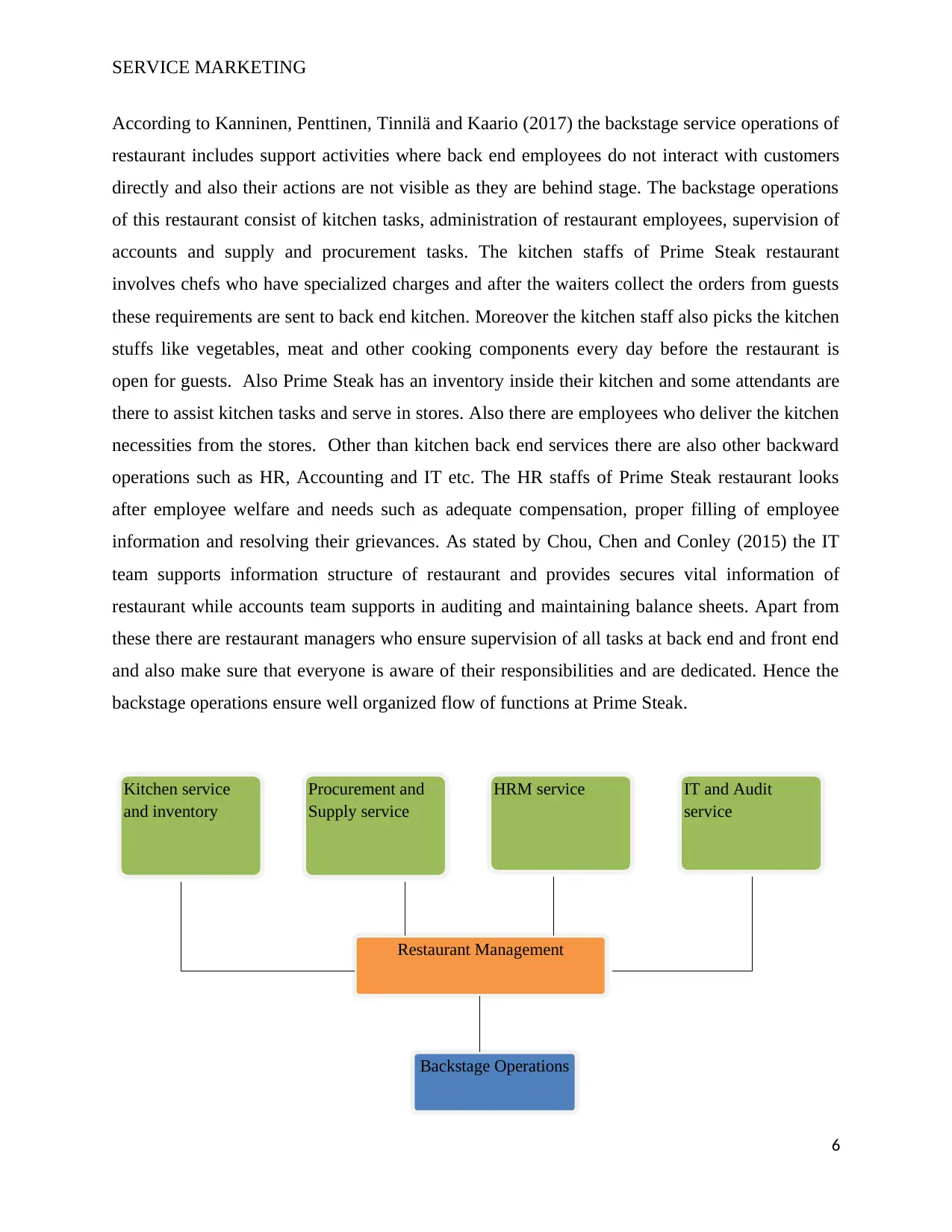
SERVICE MARKETING
According to Kanninen, Penttinen, Tinnilä and Kaario (2017) the backstage service operations of
restaurant includes support activities where back end employees do not interact with customers
directly and also their actions are not visible as they are behind stage. The backstage operations
of this restaurant consist of kitchen tasks, administration of restaurant employees, supervision of
accounts and supply and procurement tasks. The kitchen staffs of Prime Steak restaurant
involves chefs who have specialized charges and after the waiters collect the orders from guests
these requirements are sent to back end kitchen. Moreover the kitchen staff also picks the kitchen
stuffs like vegetables, meat and other cooking components every day before the restaurant is
open for guests. Also Prime Steak has an inventory inside their kitchen and some attendants are
there to assist kitchen tasks and serve in stores. Also there are employees who deliver the kitchen
necessities from the stores. Other than kitchen back end services there are also other backward
operations such as HR, Accounting and IT etc. The HR staffs of Prime Steak restaurant looks
after employee welfare and needs such as adequate compensation, proper filling of employee
information and resolving their grievances. As stated by Chou, Chen and Conley (2015) the IT
team supports information structure of restaurant and provides secures vital information of
restaurant while accounts team supports in auditing and maintaining balance sheets. Apart from
these there are restaurant managers who ensure supervision of all tasks at back end and front end
and also make sure that everyone is aware of their responsibilities and are dedicated. Hence the
backstage operations ensure well organized flow of functions at Prime Steak.
6
Kitchen service
and inventory
Procurement and
Supply service
HRM service IT and Audit
service
Restaurant Management
Backstage Operations
According to Kanninen, Penttinen, Tinnilä and Kaario (2017) the backstage service operations of
restaurant includes support activities where back end employees do not interact with customers
directly and also their actions are not visible as they are behind stage. The backstage operations
of this restaurant consist of kitchen tasks, administration of restaurant employees, supervision of
accounts and supply and procurement tasks. The kitchen staffs of Prime Steak restaurant
involves chefs who have specialized charges and after the waiters collect the orders from guests
these requirements are sent to back end kitchen. Moreover the kitchen staff also picks the kitchen
stuffs like vegetables, meat and other cooking components every day before the restaurant is
open for guests. Also Prime Steak has an inventory inside their kitchen and some attendants are
there to assist kitchen tasks and serve in stores. Also there are employees who deliver the kitchen
necessities from the stores. Other than kitchen back end services there are also other backward
operations such as HR, Accounting and IT etc. The HR staffs of Prime Steak restaurant looks
after employee welfare and needs such as adequate compensation, proper filling of employee
information and resolving their grievances. As stated by Chou, Chen and Conley (2015) the IT
team supports information structure of restaurant and provides secures vital information of
restaurant while accounts team supports in auditing and maintaining balance sheets. Apart from
these there are restaurant managers who ensure supervision of all tasks at back end and front end
and also make sure that everyone is aware of their responsibilities and are dedicated. Hence the
backstage operations ensure well organized flow of functions at Prime Steak.
6
Kitchen service
and inventory
Procurement and
Supply service
HRM service IT and Audit
service
Restaurant Management
Backstage Operations
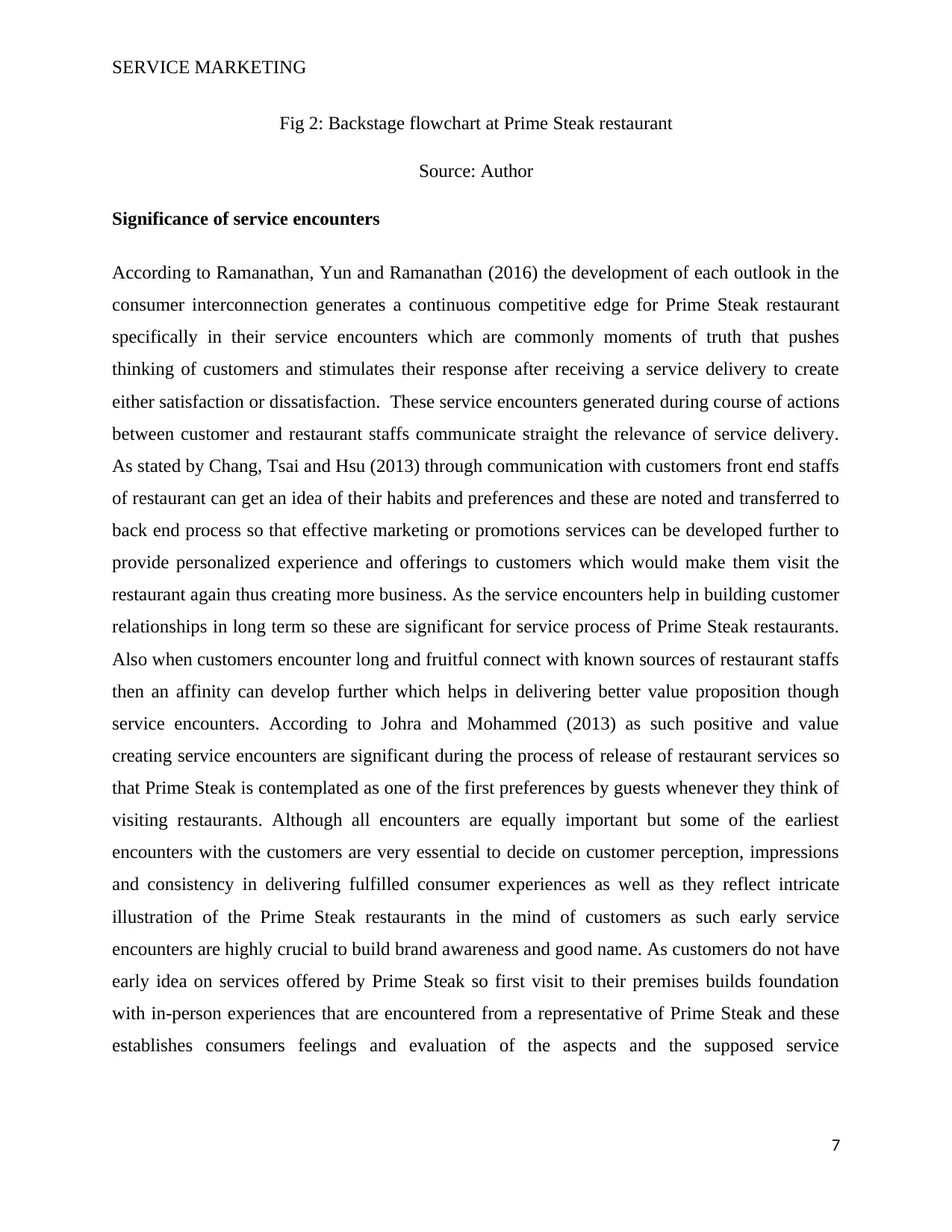
SERVICE MARKETING
Fig 2: Backstage flowchart at Prime Steak restaurant
Source: Author
Significance of service encounters
According to Ramanathan, Yun and Ramanathan (2016) the development of each outlook in the
consumer interconnection generates a continuous competitive edge for Prime Steak restaurant
specifically in their service encounters which are commonly moments of truth that pushes
thinking of customers and stimulates their response after receiving a service delivery to create
either satisfaction or dissatisfaction. These service encounters generated during course of actions
between customer and restaurant staffs communicate straight the relevance of service delivery.
As stated by Chang, Tsai and Hsu (2013) through communication with customers front end staffs
of restaurant can get an idea of their habits and preferences and these are noted and transferred to
back end process so that effective marketing or promotions services can be developed further to
provide personalized experience and offerings to customers which would make them visit the
restaurant again thus creating more business. As the service encounters help in building customer
relationships in long term so these are significant for service process of Prime Steak restaurants.
Also when customers encounter long and fruitful connect with known sources of restaurant staffs
then an affinity can develop further which helps in delivering better value proposition though
service encounters. According to Johra and Mohammed (2013) as such positive and value
creating service encounters are significant during the process of release of restaurant services so
that Prime Steak is contemplated as one of the first preferences by guests whenever they think of
visiting restaurants. Although all encounters are equally important but some of the earliest
encounters with the customers are very essential to decide on customer perception, impressions
and consistency in delivering fulfilled consumer experiences as well as they reflect intricate
illustration of the Prime Steak restaurants in the mind of customers as such early service
encounters are highly crucial to build brand awareness and good name. As customers do not have
early idea on services offered by Prime Steak so first visit to their premises builds foundation
with in-person experiences that are encountered from a representative of Prime Steak and these
establishes consumers feelings and evaluation of the aspects and the supposed service
7
Fig 2: Backstage flowchart at Prime Steak restaurant
Source: Author
Significance of service encounters
According to Ramanathan, Yun and Ramanathan (2016) the development of each outlook in the
consumer interconnection generates a continuous competitive edge for Prime Steak restaurant
specifically in their service encounters which are commonly moments of truth that pushes
thinking of customers and stimulates their response after receiving a service delivery to create
either satisfaction or dissatisfaction. These service encounters generated during course of actions
between customer and restaurant staffs communicate straight the relevance of service delivery.
As stated by Chang, Tsai and Hsu (2013) through communication with customers front end staffs
of restaurant can get an idea of their habits and preferences and these are noted and transferred to
back end process so that effective marketing or promotions services can be developed further to
provide personalized experience and offerings to customers which would make them visit the
restaurant again thus creating more business. As the service encounters help in building customer
relationships in long term so these are significant for service process of Prime Steak restaurants.
Also when customers encounter long and fruitful connect with known sources of restaurant staffs
then an affinity can develop further which helps in delivering better value proposition though
service encounters. According to Johra and Mohammed (2013) as such positive and value
creating service encounters are significant during the process of release of restaurant services so
that Prime Steak is contemplated as one of the first preferences by guests whenever they think of
visiting restaurants. Although all encounters are equally important but some of the earliest
encounters with the customers are very essential to decide on customer perception, impressions
and consistency in delivering fulfilled consumer experiences as well as they reflect intricate
illustration of the Prime Steak restaurants in the mind of customers as such early service
encounters are highly crucial to build brand awareness and good name. As customers do not have
early idea on services offered by Prime Steak so first visit to their premises builds foundation
with in-person experiences that are encountered from a representative of Prime Steak and these
establishes consumers feelings and evaluation of the aspects and the supposed service
7
Paraphrase This Document
Need a fresh take? Get an instant paraphrase of this document with our AI Paraphraser
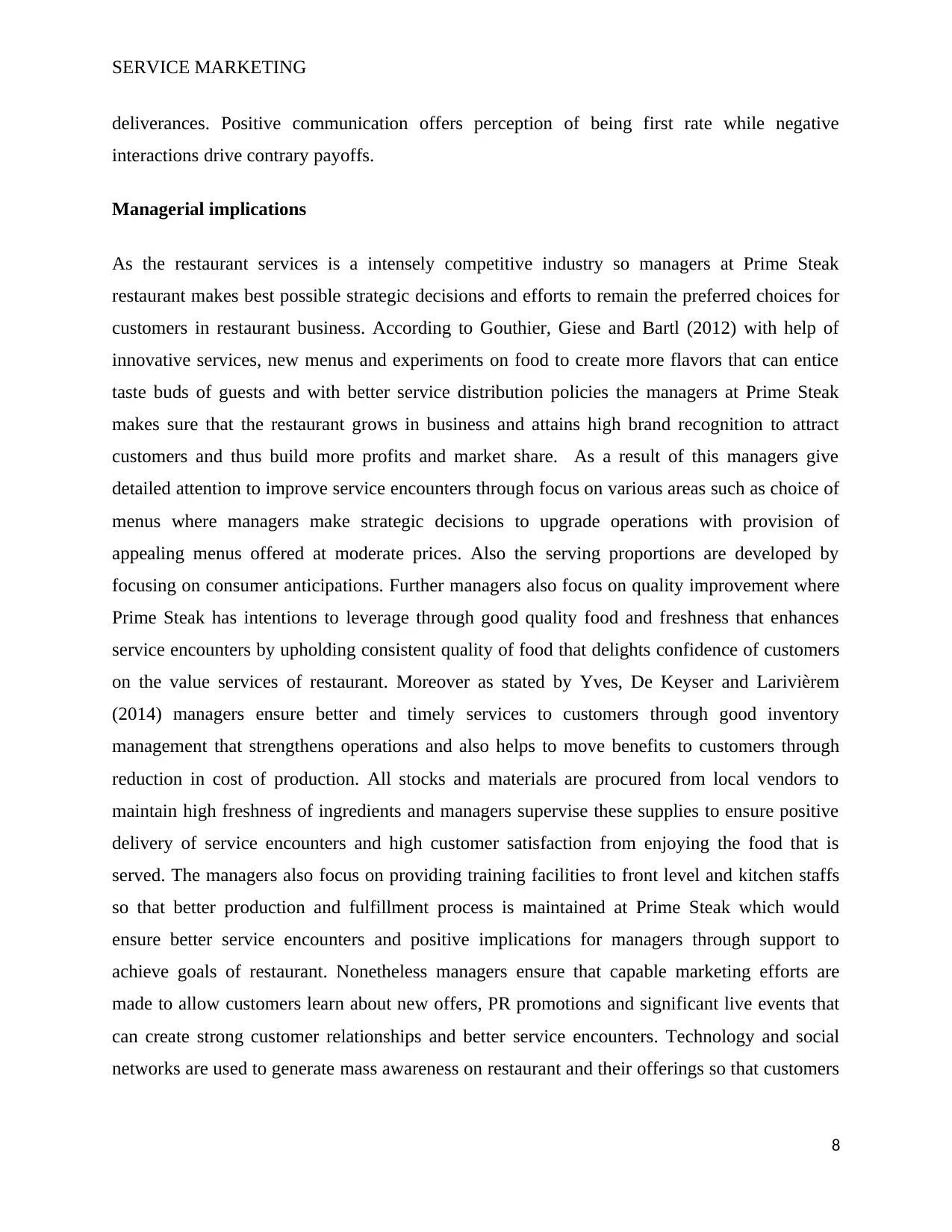
SERVICE MARKETING
deliverances. Positive communication offers perception of being first rate while negative
interactions drive contrary payoffs.
Managerial implications
As the restaurant services is a intensely competitive industry so managers at Prime Steak
restaurant makes best possible strategic decisions and efforts to remain the preferred choices for
customers in restaurant business. According to Gouthier, Giese and Bartl (2012) with help of
innovative services, new menus and experiments on food to create more flavors that can entice
taste buds of guests and with better service distribution policies the managers at Prime Steak
makes sure that the restaurant grows in business and attains high brand recognition to attract
customers and thus build more profits and market share. As a result of this managers give
detailed attention to improve service encounters through focus on various areas such as choice of
menus where managers make strategic decisions to upgrade operations with provision of
appealing menus offered at moderate prices. Also the serving proportions are developed by
focusing on consumer anticipations. Further managers also focus on quality improvement where
Prime Steak has intentions to leverage through good quality food and freshness that enhances
service encounters by upholding consistent quality of food that delights confidence of customers
on the value services of restaurant. Moreover as stated by Yves, De Keyser and Larivièrem
(2014) managers ensure better and timely services to customers through good inventory
management that strengthens operations and also helps to move benefits to customers through
reduction in cost of production. All stocks and materials are procured from local vendors to
maintain high freshness of ingredients and managers supervise these supplies to ensure positive
delivery of service encounters and high customer satisfaction from enjoying the food that is
served. The managers also focus on providing training facilities to front level and kitchen staffs
so that better production and fulfillment process is maintained at Prime Steak which would
ensure better service encounters and positive implications for managers through support to
achieve goals of restaurant. Nonetheless managers ensure that capable marketing efforts are
made to allow customers learn about new offers, PR promotions and significant live events that
can create strong customer relationships and better service encounters. Technology and social
networks are used to generate mass awareness on restaurant and their offerings so that customers
8
deliverances. Positive communication offers perception of being first rate while negative
interactions drive contrary payoffs.
Managerial implications
As the restaurant services is a intensely competitive industry so managers at Prime Steak
restaurant makes best possible strategic decisions and efforts to remain the preferred choices for
customers in restaurant business. According to Gouthier, Giese and Bartl (2012) with help of
innovative services, new menus and experiments on food to create more flavors that can entice
taste buds of guests and with better service distribution policies the managers at Prime Steak
makes sure that the restaurant grows in business and attains high brand recognition to attract
customers and thus build more profits and market share. As a result of this managers give
detailed attention to improve service encounters through focus on various areas such as choice of
menus where managers make strategic decisions to upgrade operations with provision of
appealing menus offered at moderate prices. Also the serving proportions are developed by
focusing on consumer anticipations. Further managers also focus on quality improvement where
Prime Steak has intentions to leverage through good quality food and freshness that enhances
service encounters by upholding consistent quality of food that delights confidence of customers
on the value services of restaurant. Moreover as stated by Yves, De Keyser and Larivièrem
(2014) managers ensure better and timely services to customers through good inventory
management that strengthens operations and also helps to move benefits to customers through
reduction in cost of production. All stocks and materials are procured from local vendors to
maintain high freshness of ingredients and managers supervise these supplies to ensure positive
delivery of service encounters and high customer satisfaction from enjoying the food that is
served. The managers also focus on providing training facilities to front level and kitchen staffs
so that better production and fulfillment process is maintained at Prime Steak which would
ensure better service encounters and positive implications for managers through support to
achieve goals of restaurant. Nonetheless managers ensure that capable marketing efforts are
made to allow customers learn about new offers, PR promotions and significant live events that
can create strong customer relationships and better service encounters. Technology and social
networks are used to generate mass awareness on restaurant and their offerings so that customers
8
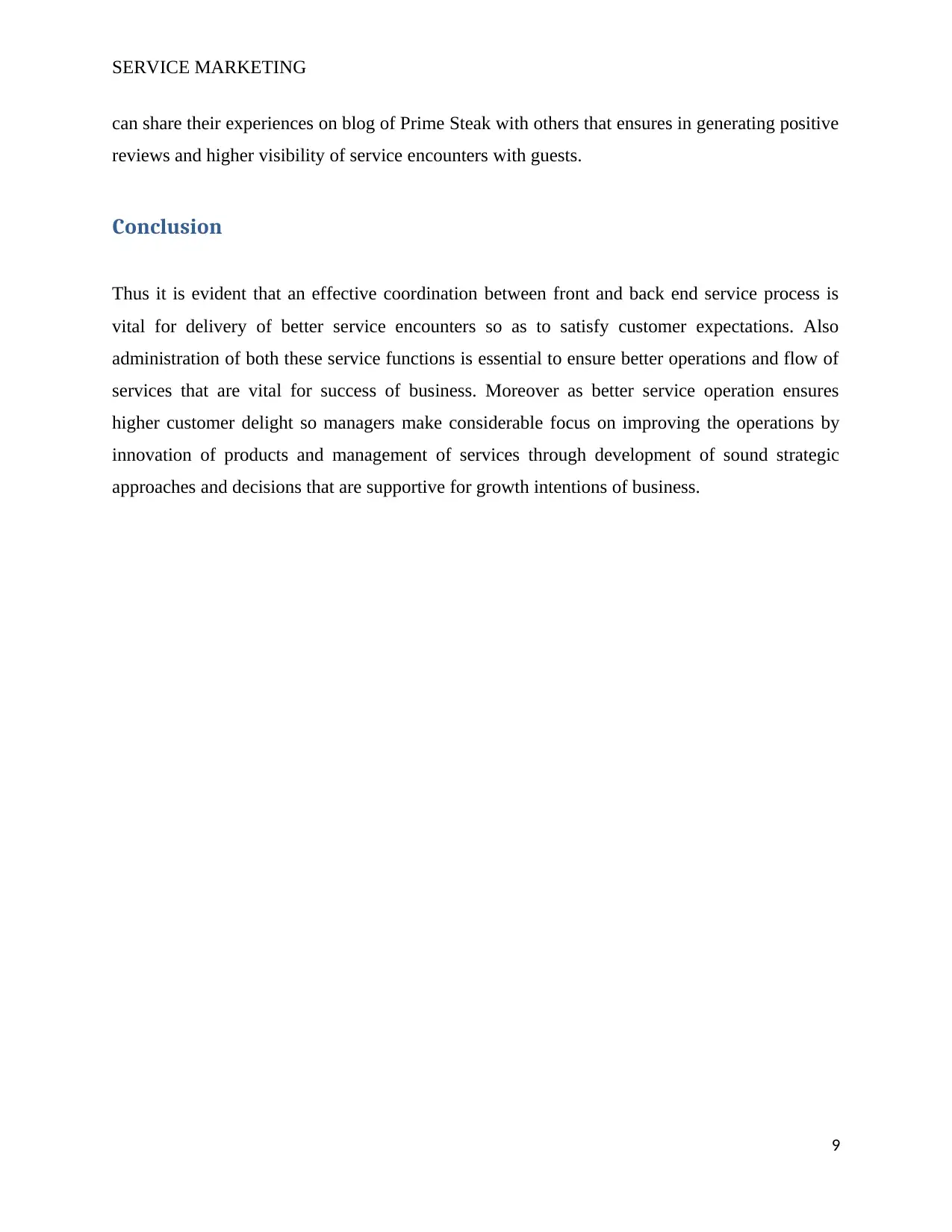
SERVICE MARKETING
can share their experiences on blog of Prime Steak with others that ensures in generating positive
reviews and higher visibility of service encounters with guests.
Conclusion
Thus it is evident that an effective coordination between front and back end service process is
vital for delivery of better service encounters so as to satisfy customer expectations. Also
administration of both these service functions is essential to ensure better operations and flow of
services that are vital for success of business. Moreover as better service operation ensures
higher customer delight so managers make considerable focus on improving the operations by
innovation of products and management of services through development of sound strategic
approaches and decisions that are supportive for growth intentions of business.
9
can share their experiences on blog of Prime Steak with others that ensures in generating positive
reviews and higher visibility of service encounters with guests.
Conclusion
Thus it is evident that an effective coordination between front and back end service process is
vital for delivery of better service encounters so as to satisfy customer expectations. Also
administration of both these service functions is essential to ensure better operations and flow of
services that are vital for success of business. Moreover as better service operation ensures
higher customer delight so managers make considerable focus on improving the operations by
innovation of products and management of services through development of sound strategic
approaches and decisions that are supportive for growth intentions of business.
9
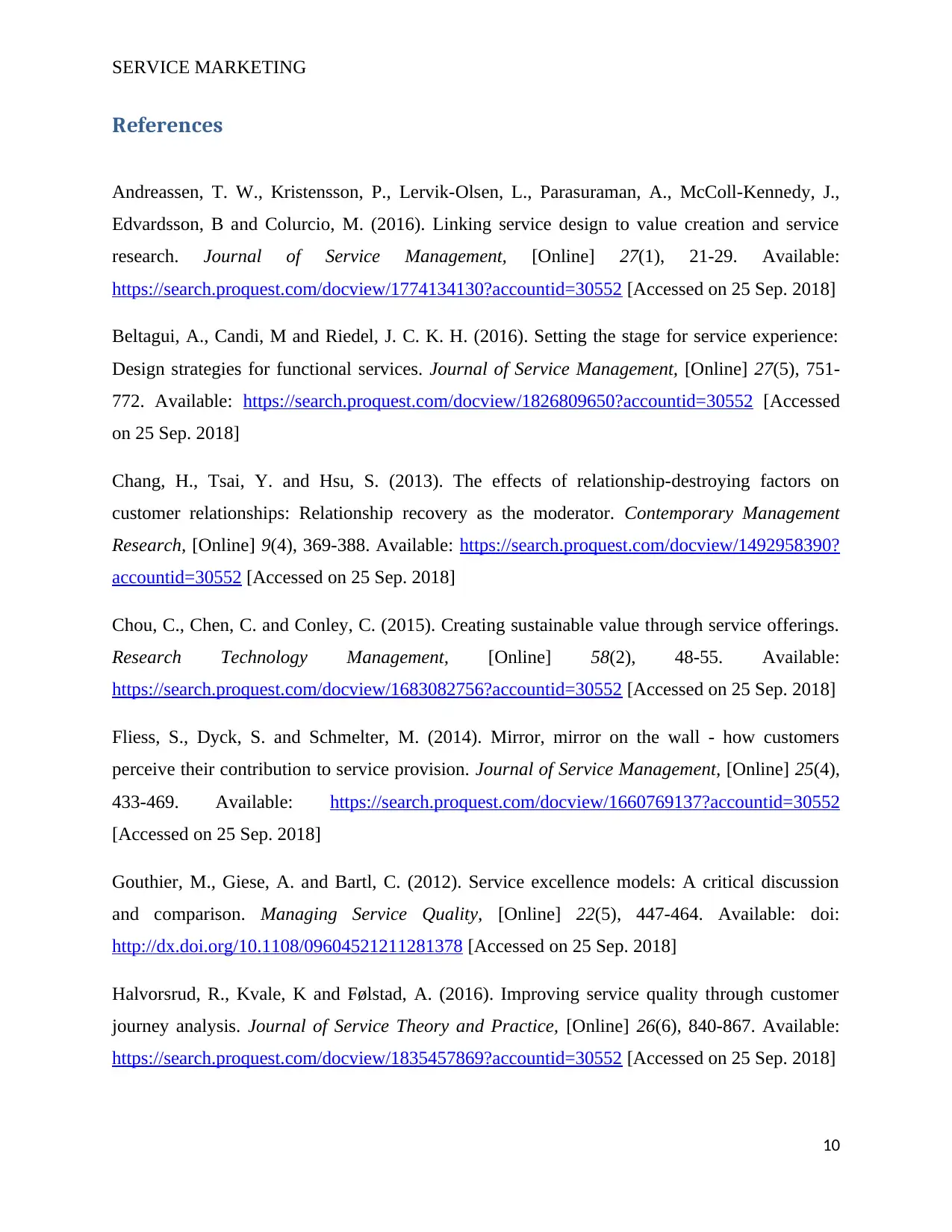
SERVICE MARKETING
References
Andreassen, T. W., Kristensson, P., Lervik-Olsen, L., Parasuraman, A., McColl-Kennedy, J.,
Edvardsson, B and Colurcio, M. (2016). Linking service design to value creation and service
research. Journal of Service Management, [Online] 27(1), 21-29. Available:
https://search.proquest.com/docview/1774134130?accountid=30552 [Accessed on 25 Sep. 2018]
Beltagui, A., Candi, M and Riedel, J. C. K. H. (2016). Setting the stage for service experience:
Design strategies for functional services. Journal of Service Management, [Online] 27(5), 751-
772. Available: https://search.proquest.com/docview/1826809650?accountid=30552 [Accessed
on 25 Sep. 2018]
Chang, H., Tsai, Y. and Hsu, S. (2013). The effects of relationship-destroying factors on
customer relationships: Relationship recovery as the moderator. Contemporary Management
Research, [Online] 9(4), 369-388. Available: https://search.proquest.com/docview/1492958390?
accountid=30552 [Accessed on 25 Sep. 2018]
Chou, C., Chen, C. and Conley, C. (2015). Creating sustainable value through service offerings.
Research Technology Management, [Online] 58(2), 48-55. Available:
https://search.proquest.com/docview/1683082756?accountid=30552 [Accessed on 25 Sep. 2018]
Fliess, S., Dyck, S. and Schmelter, M. (2014). Mirror, mirror on the wall - how customers
perceive their contribution to service provision. Journal of Service Management, [Online] 25(4),
433-469. Available: https://search.proquest.com/docview/1660769137?accountid=30552
[Accessed on 25 Sep. 2018]
Gouthier, M., Giese, A. and Bartl, C. (2012). Service excellence models: A critical discussion
and comparison. Managing Service Quality, [Online] 22(5), 447-464. Available: doi:
http://dx.doi.org/10.1108/09604521211281378 [Accessed on 25 Sep. 2018]
Halvorsrud, R., Kvale, K and Følstad, A. (2016). Improving service quality through customer
journey analysis. Journal of Service Theory and Practice, [Online] 26(6), 840-867. Available:
https://search.proquest.com/docview/1835457869?accountid=30552 [Accessed on 25 Sep. 2018]
10
References
Andreassen, T. W., Kristensson, P., Lervik-Olsen, L., Parasuraman, A., McColl-Kennedy, J.,
Edvardsson, B and Colurcio, M. (2016). Linking service design to value creation and service
research. Journal of Service Management, [Online] 27(1), 21-29. Available:
https://search.proquest.com/docview/1774134130?accountid=30552 [Accessed on 25 Sep. 2018]
Beltagui, A., Candi, M and Riedel, J. C. K. H. (2016). Setting the stage for service experience:
Design strategies for functional services. Journal of Service Management, [Online] 27(5), 751-
772. Available: https://search.proquest.com/docview/1826809650?accountid=30552 [Accessed
on 25 Sep. 2018]
Chang, H., Tsai, Y. and Hsu, S. (2013). The effects of relationship-destroying factors on
customer relationships: Relationship recovery as the moderator. Contemporary Management
Research, [Online] 9(4), 369-388. Available: https://search.proquest.com/docview/1492958390?
accountid=30552 [Accessed on 25 Sep. 2018]
Chou, C., Chen, C. and Conley, C. (2015). Creating sustainable value through service offerings.
Research Technology Management, [Online] 58(2), 48-55. Available:
https://search.proquest.com/docview/1683082756?accountid=30552 [Accessed on 25 Sep. 2018]
Fliess, S., Dyck, S. and Schmelter, M. (2014). Mirror, mirror on the wall - how customers
perceive their contribution to service provision. Journal of Service Management, [Online] 25(4),
433-469. Available: https://search.proquest.com/docview/1660769137?accountid=30552
[Accessed on 25 Sep. 2018]
Gouthier, M., Giese, A. and Bartl, C. (2012). Service excellence models: A critical discussion
and comparison. Managing Service Quality, [Online] 22(5), 447-464. Available: doi:
http://dx.doi.org/10.1108/09604521211281378 [Accessed on 25 Sep. 2018]
Halvorsrud, R., Kvale, K and Følstad, A. (2016). Improving service quality through customer
journey analysis. Journal of Service Theory and Practice, [Online] 26(6), 840-867. Available:
https://search.proquest.com/docview/1835457869?accountid=30552 [Accessed on 25 Sep. 2018]
10
Secure Best Marks with AI Grader
Need help grading? Try our AI Grader for instant feedback on your assignments.
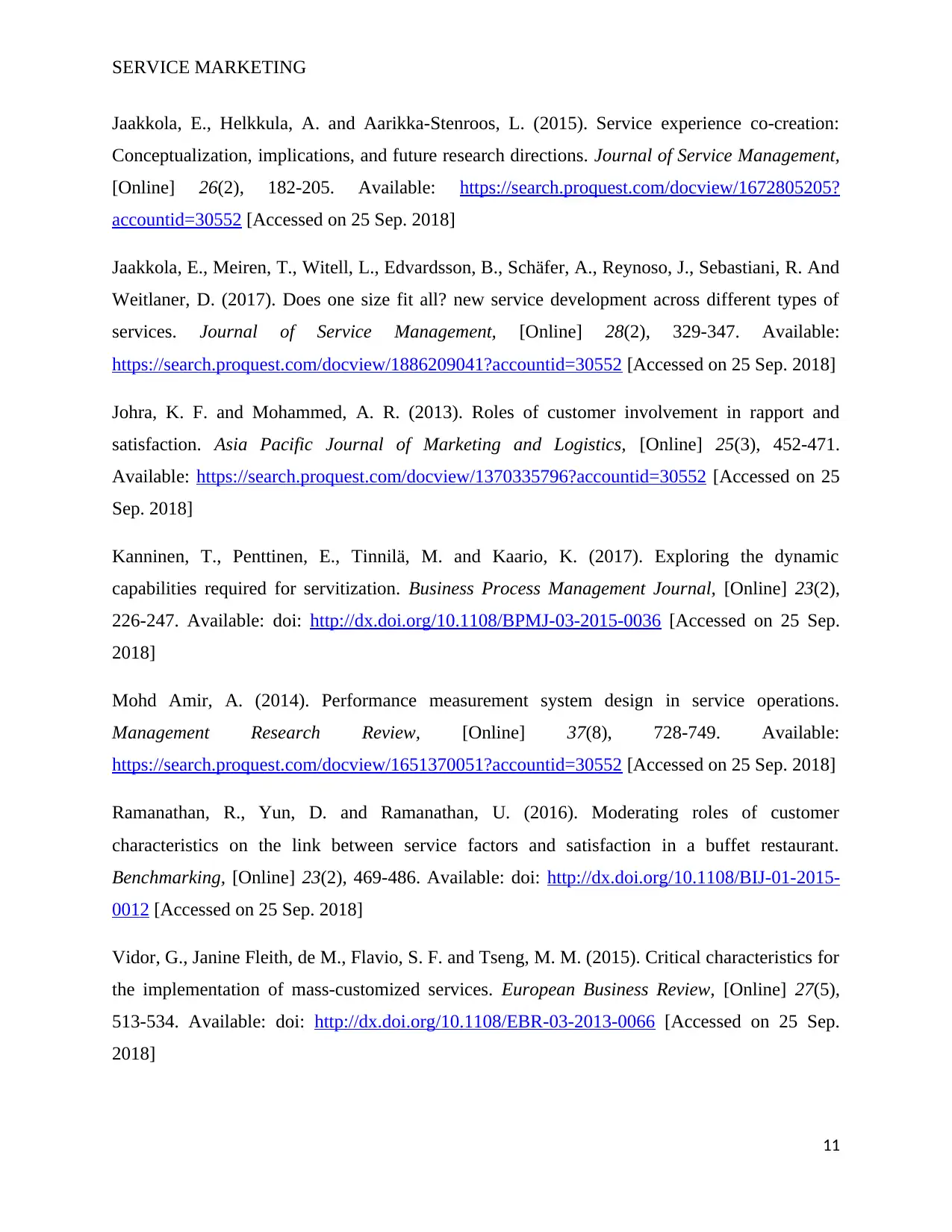
SERVICE MARKETING
Jaakkola, E., Helkkula, A. and Aarikka-Stenroos, L. (2015). Service experience co-creation:
Conceptualization, implications, and future research directions. Journal of Service Management,
[Online] 26(2), 182-205. Available: https://search.proquest.com/docview/1672805205?
accountid=30552 [Accessed on 25 Sep. 2018]
Jaakkola, E., Meiren, T., Witell, L., Edvardsson, B., Schäfer, A., Reynoso, J., Sebastiani, R. And
Weitlaner, D. (2017). Does one size fit all? new service development across different types of
services. Journal of Service Management, [Online] 28(2), 329-347. Available:
https://search.proquest.com/docview/1886209041?accountid=30552 [Accessed on 25 Sep. 2018]
Johra, K. F. and Mohammed, A. R. (2013). Roles of customer involvement in rapport and
satisfaction. Asia Pacific Journal of Marketing and Logistics, [Online] 25(3), 452-471.
Available: https://search.proquest.com/docview/1370335796?accountid=30552 [Accessed on 25
Sep. 2018]
Kanninen, T., Penttinen, E., Tinnilä, M. and Kaario, K. (2017). Exploring the dynamic
capabilities required for servitization. Business Process Management Journal, [Online] 23(2),
226-247. Available: doi: http://dx.doi.org/10.1108/BPMJ-03-2015-0036 [Accessed on 25 Sep.
2018]
Mohd Amir, A. (2014). Performance measurement system design in service operations.
Management Research Review, [Online] 37(8), 728-749. Available:
https://search.proquest.com/docview/1651370051?accountid=30552 [Accessed on 25 Sep. 2018]
Ramanathan, R., Yun, D. and Ramanathan, U. (2016). Moderating roles of customer
characteristics on the link between service factors and satisfaction in a buffet restaurant.
Benchmarking, [Online] 23(2), 469-486. Available: doi: http://dx.doi.org/10.1108/BIJ-01-2015-
0012 [Accessed on 25 Sep. 2018]
Vidor, G., Janine Fleith, de M., Flavio, S. F. and Tseng, M. M. (2015). Critical characteristics for
the implementation of mass-customized services. European Business Review, [Online] 27(5),
513-534. Available: doi: http://dx.doi.org/10.1108/EBR-03-2013-0066 [Accessed on 25 Sep.
2018]
11
Jaakkola, E., Helkkula, A. and Aarikka-Stenroos, L. (2015). Service experience co-creation:
Conceptualization, implications, and future research directions. Journal of Service Management,
[Online] 26(2), 182-205. Available: https://search.proquest.com/docview/1672805205?
accountid=30552 [Accessed on 25 Sep. 2018]
Jaakkola, E., Meiren, T., Witell, L., Edvardsson, B., Schäfer, A., Reynoso, J., Sebastiani, R. And
Weitlaner, D. (2017). Does one size fit all? new service development across different types of
services. Journal of Service Management, [Online] 28(2), 329-347. Available:
https://search.proquest.com/docview/1886209041?accountid=30552 [Accessed on 25 Sep. 2018]
Johra, K. F. and Mohammed, A. R. (2013). Roles of customer involvement in rapport and
satisfaction. Asia Pacific Journal of Marketing and Logistics, [Online] 25(3), 452-471.
Available: https://search.proquest.com/docview/1370335796?accountid=30552 [Accessed on 25
Sep. 2018]
Kanninen, T., Penttinen, E., Tinnilä, M. and Kaario, K. (2017). Exploring the dynamic
capabilities required for servitization. Business Process Management Journal, [Online] 23(2),
226-247. Available: doi: http://dx.doi.org/10.1108/BPMJ-03-2015-0036 [Accessed on 25 Sep.
2018]
Mohd Amir, A. (2014). Performance measurement system design in service operations.
Management Research Review, [Online] 37(8), 728-749. Available:
https://search.proquest.com/docview/1651370051?accountid=30552 [Accessed on 25 Sep. 2018]
Ramanathan, R., Yun, D. and Ramanathan, U. (2016). Moderating roles of customer
characteristics on the link between service factors and satisfaction in a buffet restaurant.
Benchmarking, [Online] 23(2), 469-486. Available: doi: http://dx.doi.org/10.1108/BIJ-01-2015-
0012 [Accessed on 25 Sep. 2018]
Vidor, G., Janine Fleith, de M., Flavio, S. F. and Tseng, M. M. (2015). Critical characteristics for
the implementation of mass-customized services. European Business Review, [Online] 27(5),
513-534. Available: doi: http://dx.doi.org/10.1108/EBR-03-2013-0066 [Accessed on 25 Sep.
2018]
11

SERVICE MARKETING
Yves, V. V., De Keyser, A. and Larivière, B. (2014). Customer intentions to invoke service
guarantees. Managing Service Quality, [Online] 24(1), 45-62. Available: doi:
http://dx.doi.org/10.1108/MSQ-06-2013-0115 [Accessed on 25 Sep. 2018]
12
Yves, V. V., De Keyser, A. and Larivière, B. (2014). Customer intentions to invoke service
guarantees. Managing Service Quality, [Online] 24(1), 45-62. Available: doi:
http://dx.doi.org/10.1108/MSQ-06-2013-0115 [Accessed on 25 Sep. 2018]
12
1 out of 12
Related Documents
Your All-in-One AI-Powered Toolkit for Academic Success.
+13062052269
info@desklib.com
Available 24*7 on WhatsApp / Email
![[object Object]](/_next/static/media/star-bottom.7253800d.svg)
Unlock your academic potential
© 2024 | Zucol Services PVT LTD | All rights reserved.




